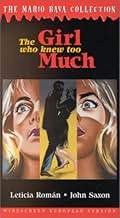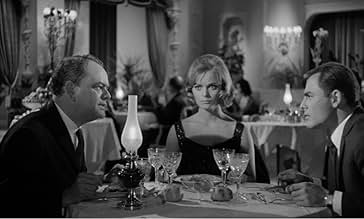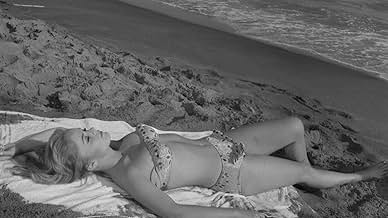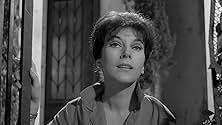En vacances à Rome, Nora Davis assiste impuissante à un meurtre. Personne ne croyant son témoignage, elle se met à accumuler les indices afin de prouver sa bonne foi. Ce jeu de piste la met ... Tout lireEn vacances à Rome, Nora Davis assiste impuissante à un meurtre. Personne ne croyant son témoignage, elle se met à accumuler les indices afin de prouver sa bonne foi. Ce jeu de piste la met sur la voie de la prochaine victime: elle-même.En vacances à Rome, Nora Davis assiste impuissante à un meurtre. Personne ne croyant son témoignage, elle se met à accumuler les indices afin de prouver sa bonne foi. Ce jeu de piste la met sur la voie de la prochaine victime: elle-même.
- Réalisation
- Scénario
- Casting principal
- Récompenses
- 1 victoire et 1 nomination au total
- Nora Davis
- (as Leticia Roman)
- …
- Dr. Alessi
- (as Robert Buchanan)
- Professor Torrani
- (as Gianni De Benedetto)
- Andrea Landini
- (as Dante Di Paolo)
- Uncle Augusto
- (non crédité)
- Asylum employee
- (non crédité)
- Woman in Sguattera Restaurant
- (non crédité)
Avis à la une
As the title imples, The Girl Who Knew Too Much is with one foot firmly set in Hitchcock territory, but whereas Hitch films had a tendency of trying to be too many things at once (little bits of comedy, romance etc) something I always considered distracting, Bava allows nothing to come between him and his goal: a suspenseful horror thriller.
The chiaroscuro photography is simply beautiful to look at, light and shadow play off each other in expressive ways, not unlike film-noir. Leticia Roman's face is at times only half-lit to stress her confusion, while in other set-pieces dark figures stand out against fully lit backgrounds. Bava is famous for being one of the best visual directors in the history of the medium for good reason. His black and white work is as good as his colour films.
Minor quibbles I had with the film include that many scares turn out to be false, the first person narration (another film-noir influence) and the implied possibilities in the ending *was it all a dream?* Leticia Roman and John Saxon hit it off with great chemistry, the DP work is fantabulous, the opening 15-20 minutes leading up to the first murder are among the best 20 minutes in 60's horror and this an all around accomplished horror film that deserves every fan's attention.
I finally got to watch this in the way of the relatively cheap French DVD-release LA FILLE QUI EN SAVANT TROP, which includes Bava's original Italian cut as well as the American cut (titled THE EVIL EYE), which has a completely different ending and excludes some references to marijuana, as well as a stronger emphasis on the romantic plot line between the two leads John Saxon and Letícia Román, reputedly to make the film more marketable for children(!), which I find impossible to comprehend, but apparently this was what U.S. distributors had in mind. Furthermore, a bombastic Les Baxter score was added, a common treatment for most U.S releases of Italian films in that period, instead of the charming jazzy score in the Italian version (and a very catchy theme song).
Letícia Román stars as a young American woman who loves reading mystery novels. In fact, she's seen reading a detective novel called "The Knife" when we meet her on the plane. She plans to stay with her aged aunt, but one evening, the old lady dies before her eyes. When she stumbles upon the streets, she witnesses a woman stabbed to death in front of the Spanish Steps and suspects it's the work of a serial killer. Going unconscious, she awakens in the hospital and tries to convince everyone she witnessed a murder, but since no body was found, nobody believes her. She does convince a young doctor (John Saxon) to help her investigate the murders, and they soon find out a series of murders was committed ten years ago, the "Alphabet Murders." She realizes that previous victims had surnames beginning A, B and C and, because her name starts with a D, she could be the next victim.
This is often cited as the first Giallo, that specific Italian breed of thriller, named after the line of books with yellow covers, hence Giallo, Italian for yellow. THE GIRL WHO KNEW TOO MUCH basically contains most core elements attributed to this particular cinematic sub-genre, with the prime motive of the helpless heroine subjected to all kinds of dangers and physical as well as mental abuse. Nora Davis is seen reading a Giallo novel on the airplane; the foreigner as vulnerable outsider in Italy; an obsession with travel and tourism, the first murder takes place before the Spanish Steps, but the film shows countless tourist hotspots throughout Rome, and the fascination with fashion and style or the jet-set in general. Although it would take Bava's own BLOOD AND BLACK LACE (1964), lavishly shot in colour, to introduce the more elaborate, lengthy and - above all - much more violent and bloody killing sequences which would typify many later Giallos, carried out by the archetype Giallo killer with gloves and black raincoat. Wide-eyed Letícia Román is the kind of innocent looking girl with just the right combination of sexiness and innocence to pass as a very likable heroine, perhaps a touch too innocent and certainly worlds away from the sexually liberated female in later Giallos.
Early sixties' fashions and habits abound, such as Nora Davis' exuberant snake leather jacket. There's also a lot of smoking on the plane and later on Nora condones Marcello's smoking habits claiming it's bad for his health, which is presented as the audience is supposed to laugh at her "preposterous" observation, instead of Marcello's smoking habit. Typical role reversal. There's also the running gag with marijuana. In the first scene, the man next to Nora on the plane turns out to be a marijuana smuggler, but on arrival in Rome, the always alert Italian police is quick to take this character into custody. Perhaps Bava's way of saying the Italian police is always on top of these issues and malicious elements from abroad are dealt with in proper fashion.
Masterfully shot in black-and-white, the film doesn't contain the outrageous imagery of THE BODY AND THE WHIP (1963) and BLOOD AND BLACK LACE, both sumptuously shot in colour, and certainly is much lighter in tone with the sadistic bloodletting so typical of that other pivotal entry in the development of the Giallo, BLOOD AND BLACK LACE, largely lacking. Originally, it was conceived as a romantic comedy and - hence the title - as a light parody on Hitchcock's work, but Bava decided to put a larger emphasis on the more horrific elements of the story, but doesn't lose sight of the plot development, which I always found a major demerit of BLOOD AND BLACK LACE. A bit old-fashioned perhaps by American or British standards, but combining these elements with a more typical Italian tone, Bava does create something new here. Nevertheless, the tone remains conspicuously breezy and that's probably why this film turns out to be such an endearing mixture of clever Hitchcockian suspense and the occasional comedy relief. Perhaps a bit too cutesy and innocent for many Bava-fans, but I found his a thoroughly enjoyable film.
Camera Obscura --- 8/10
- Nora Davis (Leticia Roman) is a young woman hoping to have a wonderful vacation in Italy. Within 24 hours of her arrival, she is almost mistakenly arrested for drug smuggling, the aunt she is staying with dies, she has her purse stolen, and she witnesses a murder. But the police can find no body and no signs of a murder. It seems that no on believes her. It's up to Nora to discover the truth to what happened that rainy night in the plaza.
- Mario Bava is known for his magnificent use of color. So, it's a little odd that two of my favorite films that Bava made (The Girl Who Knew Too Much and Black Sunday) are black & white. Whatever the format, Bava again demonstrates his mastery of shadows and light very effectively. The film presents a series of images that are hard to forget. Each shot is perfection. One of my favorites is of the thief who steals Nora's purse as he moves from one side of the stairs to the other. It is admittedly a very minor moment, but Bava puts more care into this insignificant tracking shot than most director's do in the main scenes of their movies. It is one of the most beautiful films I've ever seen.
- The Girl Who Knew Too Much is an obvious (and not just in title) homage to Alfred Hitchcock. Bava has loaded the movie with moments that are done as I imagine Hitchcock would have done them. If the movie weren't in Italian, you would swear Hitchcock directed it.
- But the thing that make this movie so effective is Leticia Roman as Nora. Her performance is one of the best I've seen in a Bava film. She comes off as fragile, yet determined, depending upon what the script calls for. She has a believability that is necessary for this kind of movie if the audience to feel concern when she is in peril. Roman is perfect in the role.
- One final note, this movie is often cited as the first giallo. Whether this is true or not, I only know what I've read. The Girl Who Knew Too Much does establish a very elementary framework for later gialli to follow. But, it bears little resemblance to the gialli that would come later. It's not until Bava fleshed-out the giallo in Blood and Black Lace do we get look and "rules" that have become so familiar to fans of the genre.
As the title suggests, The Girl Who Knew Too Much is indebted to Alfred Hitchcock more than anything else. The idea of an innocent thrust into the middle of a deadly situation is one Hitchcock used many times. While the romantic sub-plot and moments of light comedy also recall his work. These latter two elements are mainly what mark out TGWKTM as a cross-over film, as they are certainly not features of giallo cinema as it would develop. But the light, comic approach is one of the things that make this one of the most playful and upbeat films that Mario Bava ever made. Unlike his three other gialli, this film actually has sympathetic characters. While it doesn't have the melodramatic tendencies that those ensemble movies had either. The approach is much more restrained, with a fairly simple amateur sleuth narrative being the framework. Completely different too is the black and white aesthetic. Bava is of course rightfully famous for his masterful use of colour but in this film he shows that his use of light and contrast is just as impressive. This is a very handsome looking movie. Letícia Román adds to this aesthetic too of course, seeing as she is a very beautiful woman. Visually, this is a terrific film. Story-wise, it's certainly less interesting. The fairly mechanical plot is sufficient enough in taking us from A to B but it isn't particularly memorable. But it does introduce some of the motives that would go on to form an important part of giallo cinema such as the convoluted mystery, the bizarre reasoning for murder and the importance of optical subjectivity as well as the focus on style over substance.
The Girl Who Knew Too Much is a film that should be seen by fans of Mario Bava as well as dedicated students of all things giallo. It's a film that is as breezy and light as the genre ever got. It's a lovely and beautiful looking flick from a master film-maker.
The usual Gialli trademarks are already beginning to take shape here, with the film focusing on a foreigner - in this case, twenty-year old American student Nora Davis - who travels to Rome to visit her ailing aunt and inadvertently witnesses a murder. Alongside this central plot device, which would be utilised by Argento in many of his greatest films, such as the three aforementioned, we also have the ideas of sight and perception; with the central protagonist unintentionally witnessing something that is shrouded in elements of doubt and abstraction, and thus having to prove what she saw to sceptical police officers and those nearest to her. Bava's film is also given a neat touch of self-referential sub-text; opening with a shot of the central character herself reading a Giallo murder mystery, casting some doubt as to whether or not the film plays out in the literal sense, or whether it is a merely a constructed reality, taking place in her own mind as she reads the book to herself. This is a thread of interpretation that is examined throughout by the filmmaker, with the title of the book itself, "The Knife", having an importance on the plot that perhaps surreptitiously suggest some element of imagined fantasy.
Once we get through those hectic opening sequences, which introduce the characters and a number of potential sub-plots that are essentially window-dressing to throw us off the trail, the film settles into the murder mystery aspect and the burgeoning relationship between Nora and her young doctor friend, Marcello Bassi. Through the relationship, Bava introduces a subtle comment on the Holmes vs. Watson partnership recast as a romantic dilemma, whilst also creating space within his story to let the audience catch up and think about the potential clues already collected in order to lead us to the eventual discovery of the killer's identity. The use of sight and Bava's directorial slight-of-hand is used meticulously for the initial murder sequence; with the director creating a literal feeling of hazy disconnection and a distorted perspective through a somewhat dated visual effect and the always masterful use of light and shadow. Although the actual effect - which replicates the look of ripples on a pond - might lead a more contemporary audience to giggle or cringe, it does tie in with the continual use of water-symbolism in Bava's work, from the final story in The Three Faces of Fear/Black Sabbath (1963), and A Bay of Blood (1971) most famously, as well as a somewhat cheap gag about marijuana cigarettes that will pay off in the film's closing moments.
Again, the use of humour taps into the spirit of Hitchcock, with intrigue, voyeurism, suspense and murder being reduced to mere complications in the continual romantic wooing of Nora by the charming Dr. Bassi. Nevertheless, the thriller aspects are what we remember most clearly; with Bava's always atmospheric direction, iconography and ability to create tension from the slightest movement of the camera. Once the credits have rolled, we release just how subtle much of Bava's use of sight and perception actually was; with a number of scenes leading on from a moment of confusion by the central character, in which she thinks she sees something that turns out to be nothing of the sort. Again, it shows the director playfully undermining the central character; presenting Nora as someone unable to trust her own eyes, and thus, unable to be trusted with the ultimate unravelling of the plot. Nonetheless, Bava also succeeds in throwing us into this enigmatic mystery; undermining our own perspective of the story by showing us important information early on, allowing us to feel superior to Nora with our benefit of a forewarning, only to then cast further doubt in our mind as the gallery of suspects mount up.
Though still something of a minor work for Bava, The Girl Who Knew Too Much is undoubtedly great; enlivened by the fine performances from the two leads, John Saxon (a cult actor with an impeccable list of credits) and the delightful Leticia Roman (I'm honestly quite smitten), and absolutely brimming with style and energy. The gag at the end is in-keeping with Bava's work, but certainly doesn't lessen the impact of the more thrilling scenes that came before, or the air of grand mystery and excitement suggested by his excellent approach to editing, cinematography and design. Beware that the film also exists under the title The Evil Eye; re-edited by Bava for the American market as more of a light-hearted romp (Tarantino calls it's a masterpiece). The version reviewed here is the original Italian version, a minor masterpiece of Giallo thrills, cinematic abstractions and an old-fashioned approach to storytelling that grips us from the start and never lets us go.
Le saviez-vous
- AnecdotesMario Bava was a big fan of Alfred Hitchcock, and Hitchcockian touches abound in the film, including a cameo by the director. In the scene where Letícia Román is in her bedroom at Ethel's home, the portrait on the wall with the eyes that keep following her is that of Mario Bava.
- GaffesWhen Nora answers the phone in the Torrani house, "hello" is heard before she speaks, even while the receiver is being lifted to her mouth.
- Citations
Nora Davis: [into the phone] Oh mother, murders don't just happen like that here.
- Versions alternativesAIP released this as The Evil Eye, a recut version with material used just in some countries out of Italy.
- ConnexionsFeatured in Mario Bava: Maestro of the Macabre (2000)
- Bandes originalesFurore
(Appears in the Italian version)
Sung by Adriano Celentano
Written and Composed by Adriano Celentano (as Adicel) and Piero Vivarelli (as Vivarelli)
Published by Edizioni Nazionalmusic and Disco Jolly
Meilleurs choix
- How long is The Evil Eye?Alimenté par Alexa
Détails
- Date de sortie
- Pays d’origine
- Langues
- Aussi connu sous le nom de
- The Evil Eye
- Lieux de tournage
- Sociétés de production
- Voir plus de crédits d'entreprise sur IMDbPro
- Durée
- 1h 28min(88 min)
- Couleur
- Mixage
- Rapport de forme
- 1.66 : 1





























